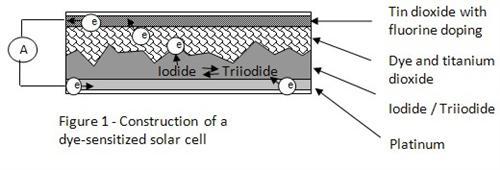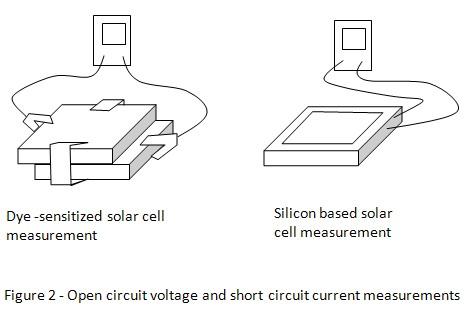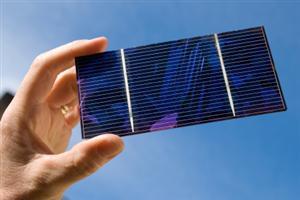| Complexity level: | 9 |
| Project cost ($): | 90 |
| Time required: | 2 days to prepare, 1 hour for experiment |
| Material availability: | Access to your school's science lab is required |
| Safety concerns: | Handle chemicals with care. Proper laboratory gear/gloves should be worn. Ensure that chemicals are properly disposed of. |
Hypothesis
Silicon based solar cells are more efficient than normal silicon based solar cells, and are therefore able to produce more power, with the same amount of light.
Overview
Dye-sensitized solar cell
Dye-sensitized solar cell or Gratzel cells are a type of low-cost thin-film solar cell. These solar cells do not require any sophisticated equipment to be manufactured. The raw materials used to construct these solar cells in also very inexpensive.
The construction of the dye-sensitized solar cell consists of an anode which is a thin layer of tin-dioxide doped with fluorine on a glass surface. Below the anode is the photosensitive layer consisting of a mixture of dye with titanium dioxide. Under this mixture is a layer of iodide acting as the electrolyte, supported on top of the cathode plate, which is normally made of platinum.

When light photons reach the dye molecules, if there is enough energy, they will release an electron to the titanium dioxide. From there the electron will reach the anode plate. The dye molecule will obtain an electron from the iodide electrolyte. This process will oxidize the iodide into triiodide. The triiodide will recover the electrons through the returning current via the platinum plate at the bottom.
Scientific Terms
Materials
The materials required for this science fair project:
- 2 glass plates (30mm x 30mm) – one side must be conductive
- 1 digital multimeter
- 1 ammeter
- 1 small bottle of ethanol
- 1 eye dropper
- Titanium dioxide solution
- Raspberry juice
- 1 pencil
- Iodide solution
- 1 small packet of tissue paper
- 1 small plate
- 2 jumper wires with crocodile clips
- 2 binder clips
- 1 silicon solar cell from an old calculator
Procedure
1. For this experiment, the independent variable is the type of solar cell, a dye-sensitized solar cell or a silicon based solar cell. The dependent variable is the open circuit voltage and short circuit current of the solar cells. This is determined by measuring the voltage and current (amperes). The constants (control variables) are the dimensions of the solar cell, the use of raspberry juice and the amount of sunlight.
2. The dye-sensitized solar cell is assembled as follows :
a. Clean the first glass plate with ethanol. Determine the side of the glass that conducts using the multimeter (set to "ohm"). Apply 2 drops of titanium dioxide on the conductive surface, and spread evenly. Let the titanium dioxide dry overnight on a hot plate.
b. Pour the raspberry juice into a second plate. Place the 1st glass plate into the raspberry juice with the titanium dioxide surface face down. Let it soak for 20 minutes. After that remove the first glass plate and gently wipe off the excess juice with tissue paper.

c. Prepare the second glass plate by cleaning it with ethanol. Again, determine the conductive side by using the multimeter. On the conductive surface, use a pencil to coat the surface with a layer of carbon.
d. Place the firstglass plate over the second glass plate so that the carbon surface will meet the titanium dioxide and raspberry juice surface. Let the plates overlap about 5mm and hold them together using the binder clip.
e. Using the dropper, place a few drops of iodide on the overlapping sides and allow the iodide to seep through in between the two glass plates.

3. Connect the dye-sensitized solar cell as shown in figure 2 and place it under the sunlight. Measure the open circuit voltage using the voltmeter and short circuit currents using the ammeter. Record the measurements in the table below.
4. Repeat the open circuit voltage and short circuit current measurements using the silicon based solar cell after placing it under that same amount of sunlight. Record the measurements in the table below.


Results
The results show that the silicon based solar cell has a higher open circuit voltage and short circuit current compared to the dye-sensitized solar cell.
|
Solar cell type |
Open circuit voltage (V) |
Short circuit current (miliampere) |
|
Dye sensitized solar cell |
0.395 |
0.105 |
|
Silicon based solar cell |
0.455 |
0.315 |
Conclusion
The hypothesis that silicon based solar cells are able to produce more power is proven to be true.
Dye-sensitized solar cells are are product of third generation of solar cell technology. Research shows that whilst silicon based solar cells are able to operate at 15% peak power production efficiency,dye-sensitized cells can achieve 11% compared to other thin film technology at only about 8%.
Also consider
The experiment can be repeated by using different fruit juices such as blueberry or cranberry juice.
Try to repeat the experiment using a larger glass slide.
References
Dye sensitized solar cell - http://en.wikipedia.org/wiki/Dye-sensitized_solar_cell
How dye sensitized solar cells work? - http://www.solideas.com/solrcell/howworks.html
Instructions for building a Gratzel solar cell -http://teachers.usd497.org/agleue/Gratzel_solar_cell%20assets/instructions%20for%20making%20the%20gratzel%20cell.htm

